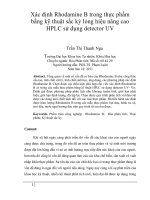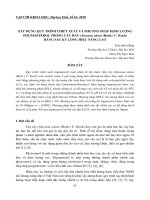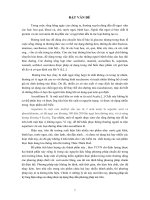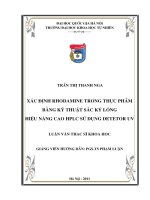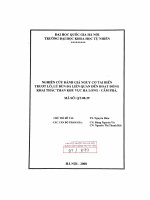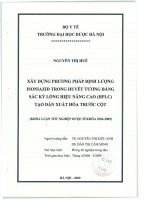Hướng dẫn sử dụng máy sắc ký lỏng hiệu năng cao bestpractice en
Bạn đang xem bản rút gọn của tài liệu. Xem và tải ngay bản đầy đủ của tài liệu tại đây (289.48 KB, 20 trang )
Best Practices for Using an Agilent
LC System
Technical Note
Best Practices - Technical Note
This technical note describes best practices for using an Agilent LC system.
Contents
Housekeeping
2
How to deal with solvents 2
How to prepare samples 3
Daily / Weekly tasks
4
Power up / Shut-down the system
5
Power-up the system 5
Shut-down the system 6
Recommendations for degassers
Recommendations for pumps
7
8
Recommendations for Pumps with MCGV 8
Seal Wash (usage mandatory when installed) 9
Recommendations for samplers
13
Recommendations for pumps and samplers with optional inline filter
Recommendations for columns
Recommendations for detectors
15
16
Additional Information for 1290 Infinity and 1290 Infinity II Pumps
Agilent Technologies
17
14
Housekeeping
How to deal with solvents
Housekeeping
How to deal with solvents
• Use clean bottles only.
• Use borosilicate glass bottle only.
• Rinse bottle with desired solvent before refilling it.
• Bottles can get contaminated with detergents form the dishwasher.
• Exchange water-based solvents daily.
• Algae growth may block the degasser or filters.
• Precipitation of insoluble salts may block filters or capillaries.
• Select solvent volume to be used up within 1 – 2 days.
• Use only HPLC-grade solvents and water filtered through 0.2 àm filters.
ã Residues or contaminations may block filters or capillaries.
• Label bottles correctly with bottle content, and filling date / expiry date.
• Use solvent inlet filters to protect the system from incoming particles.
• Reduce risk of algae growth: use brown bottles for aqueous solvents, avoid direct
sunlight or wrap the bottles in aluminium foil.
C AU T I O N
Contaminated seal wash solvent
➔ Do not recycle seal wash solvent to avoid contamination
➔ Weekly exchange seal wash solvent
➔ Use of Seal Wash Bottle Head Kit (5067-6131) is strongly recommended
Extra measures with Acetonitrile (ACN)
• Filter ACN using a 0.45 µm nylon filter.
NOTE
Filtering through nylon filters is not recommended for High Sensitivity LCMS.
• Fill ACN in brown bottles and keep amount to minimum to prevent photochemical
reactions and oxidation.
NOTE
Add 5 – 10 % water to ACN, especially for LCMS applications when 0.1 % formic acid is present (if
possible).
• Flush the system monthly with warm water (60 – 70 °C (140 – 158 °F)) - 1 L at
2 mL/min to dissolve traces of ACN reaction products.
2
Housekeeping
How to prepare samples
How to prepare samples
C AU T I O N
Possible sample precipitation
➔ Take care that the sample is complete soluble in both, the used sample solvent and the
mobile phase at starting conditions.
➔ Match the sample solvent matches and the proposed mobile phase as closely as possible to
prevent precipitation.
• Filter, decant, or centrifuge sample to separate from insoluble solid.
• Take care that the sample solvent is free of particles.
3
Daily / Weekly tasks
How to prepare samples
Daily / Weekly tasks
Daily tasks
• Replace solvents and solvent bottles for mobile phases based on water/buffer.
• Replace solvents and solvent bottles for organic mobile phase latest every second
day.
• Check presence of seal wash solvent.
• Purge each channel with fresh solvent at 2.5 – 3 mL/min for 5 min.
• Equilibrate your system with composition of your application for 15 min. Use
conditioning for 1290 systems.
Weekly tasks
• Change seal wash solvent (10 % / 90 % isopropanol/water) and bottle.
• Flush all channels with water at 2.5 – 3 mL/min for 5 min to remove salt deposits if
buffer applications were used.
• Inspect solvent filters for dirt or blockages. Clean or exchange if no flow is coming
out of the solvent line when removed from the degasser inlet.
4
Power up / Shut-down the system
Power-up the system
Power up / Shut-down the system
Power-up the system
Power up the pump
• Use new or different mobile phase (as required).
• Purge each channel with 2.5 – 3 mL/min for 5 min. Open the purge valve (1260) or
use the purge command (1290).
• Equilibrate your system with composition of your application for 15 min. Use
conditioning for 1290 systems.
Power up the sampler
• Purge the autosampler daily, and before and after sample analysis, especially if you
are using buffers.
• Set flow to required value of your application and close the purge valve.
• Pump for approximately 10 min.
• Use fresh needle wash and/or needle seat backflush solvents like methanol or
acetonitrile and water mixtures without buffer.
• Ensure that the vials contain enough sample solution for all injections.
Power up the detector
• Warmup the lamp for at least 1 h.
• For RI detectors only: flush the reference and sample side with fresh solvent used
for the current application.
5
Power up / Shut-down the system
Shut-down the system
Shut-down the system
NOTE
Use 50\50 Methanol\Water or 2-propanol\Water without additions to store system.
Long-term storage of the column
• Flush the column with appropriate solvent found in the column manual.
• Remove and seal column, and store according to good laboratory practice if needed.
Long-term shut-down of the system
• Flush system with water to remove buffer.
• Remove all samples from the sampler and store according to good laboratory
practice.
• Use recommended solvents to store the system.
• Power off the system.
6
Recommendations for degassers
Shut-down the system
Recommendations for degassers
C AU T I O N
Condensation of vapor inside the degasser
If an internal or high performance degasser is used with low boiling solvents, the solvent vapors
can condensate inside the degasser chamber when the vacuum pump is turned off.
➔ Purge all solvent channels with 2-propanol and let the degasser pump for two more hours.
• Check compatibility of solvent with degasser and application
• Use internal or high performance degassers for standard applications
• Use the standard degasser (G1322A or G7122A) for RI applications
• Use the standard degasser for high volatile solvents with vapor pressure below
100 mbar at room temperatur.
• Use the Evacuation Mode if degassing performance of internal degassers is not
optimal. Access it in the degasser control from the instrument control screen in the
Agilent LabAdvisor.
Figure 1
NOTE
Degasser Control for internal degassers in Agilent LabAdvisor
Follow the instructions prompted on the screen when starting the Evacuation Mode.
7
Recommendations for pumps
Recommendations for Pumps with MCGV
Recommendations for pumps
• Check pumps performance on regular basis.
• Perform preventive maintenance in the recommended usage interval.
• Prepare the pump as recommended like described in the power up section to ensure
optimal performance and best life time.
• Use the seal wash function as recommended to ensure optimal performance and
best life time, see below.
Recommendations for Pumps with MCGV
Select channels for Multi-Channel Gradient Valve (MCGV)
• Use lower channels (A and/or D) for buffer solutions.
• Regularly flush all MCGV channels with 200 mL of warm water to remove possible
salt deposits.
• Check compatibility of buffers and organic solvents to avoid precipitation in the
MCGVs mixing chamber.
NOTE
8
When mixing incompatible solvents, salts can precipitate at the point of mixing blocking the
downstream flow path and damaging parts.
Recommendations for pumps
Seal Wash (usage mandatory when installed)
Seal Wash (usage mandatory when installed)
Seal Wash (G4204A, G4220A, all 1260 Pumps)
C AU T I O N
Contaminated seal wash solvent
➔ Do not recycle seal wash solvent to avoid contamination
➔ Weekly exchange seal wash solvent
➔ Use of Seal Wash Bottle Head Kit (5067-6131) is strongly recommended
Using the seal wash function is strrongly recommended when using water or water
based solvents like buffer, other non-volatile solvents or additives that could deposit
on pistons and seals. The seal wash function regularly cleans these parts
automatically.
Benefits of Seal Wash Operation:
• Removal of particles, salt crystals and other non-volatile residues from the pistons
and seals, which have the potential to damage the piston and piston seals
• Lubrication of seal/piston interface
• Cooling of pistons
Seal Wash Dialog in your CDS
The dialog can be found under the control screen, it is recommended to use the
settings displayed in Figure 2 on page 10.
Be aware that:
• The seal wash settings are NOT method parameters
• The seal wash has to be turned on again manually after:
• An ERROR has been cleared
• Power on
Seal Wash Operation:
• PERIODIC operation, for example 0.5 min every 7 min
• Setting can be changed in the Control screen, see Figure 2 on page 10.
The settings are available via the context menu, see Figure 4 on page 10.
• Typical solvent flow is 0.7 mL/min what corresponds to an approximate
consumption of 3 mL/h of or 0.5 L/week at constant operation
• Use 10 % 2- Propanol in water
• 100 % 2- Propanol for normal phase applications
• Position wash solvent bottle above and waste bottle below instrument
• DO NOT recycle the seal wash solvent
• Usage of the Seal Wash Bottle Head Kit is recommended (Agilent Part Number:
5067-6131)
9
Recommendations for pumps
Seal Wash (usage mandatory when installed)
• Exchange solvent weekly
• Do not refill seal wash solvent, always use properly cleaned, fresh bottles
• Test Peristaltic Pump
• Touch the peristaltic pump with you finger to check that the pump is working, or
confirm seal wash solvent flow by looking seal wash solvent dropping out of the
tubing
Table 1
Seal wash dialog and operation
G4204A, G4220A
all 1260 Pumps
Figure 2
Seal wash settings (1290 Infinity Pumps)
Figure 3
Seal wash settings (all 1260 pumps)
Figure 4
Context Menu (1290 Infinity Pumps)
Figure 5
Context Menu (all 1260 pumps)
10
Recommendations for pumps
Seal Wash (usage mandatory when installed)
Seal Wash (G7104A, G7120A)
C AU T I O N
Contaminated seal wash solvent
➔ Do not recycle seal wash solvent to avoid contamination
➔ Weekly exchange seal wash solvent
➔ Use of Seal Wash Bottle Head Kit (5067-6131) is strongly recommended
The seal wash pump is turned on when the analytic pump is moving solvent to remove
deposits from pistons and seals. The seal wash function regularly cleans these parts
automatically.
The seal wash sensor will constantly check the performance of the seal wash system
and warn the user in case an anomaly has been detected.
Seal Wash Operation:
• The seal wash interval is set to 30 s on every 7 min.
• The flow is set to 500 àL/min.
ã The integrity of the seal wash system is checked at regular intervals
• Typical solvent usage is about 1 L per week
• Use 10 % isopropanol in water
• 100 % isopropanol for normal phase applications
• Position wash solvent bottle above and waste bottle below instrument
• DO NOT refill the seal wash solvent, always use properly cleaned, fresh bottles
• Usage of the Seal Wash Bottle Head Kit is recommended (Agilent Part Number:
5067-6131)
• Exchange solvent weekly
• DO NOT recycle seal wash solvent bottles
11
Recommendations for pumps
Seal Wash (usage mandatory when installed)
• The EMF symbol will turn yellow once the pumps seal wash sensor detects an
irregularity
• Change the seal wash solvent and trigger the Seal Wash Prime function from the
context menu (see Figure 6 on page 12)
Figure 6
Context Menu
• Check seal wash tubing and filter for kinks, leaks or blockages
• Check for blockages of the waste tubings, make sure that the solvent waste can
drain off freely:
If solvent waste is building up in the tube, the sensor can’t perform correctly
• Check the peristaltic pump for function
• Touch the peristaltic pump with you finger to check that the pump is working,
or
• Confirm seal wash solvent flow by looking seal wash solvent dropping out of
the tubing
12
Recommendations for samplers
Seal Wash (usage mandatory when installed)
Recommendations for samplers
• Purge the autosampler after sample analysis.
• Remove buffer with HPLC grade water.
• Remove contaminating substances with a strong solvent, for example pure
acetonitrile.
• Toggle the injection valve between Mainpass and Bypass while purging.
• Always use fresh wash solvent for the needle or seat wash function.
• Remove buffer with HPLC grade water.
• Remove contaminating substances with a strong solvent, for example pure
acetonitrile.
• Place the wash solvent reservoir for needle wash (optional: needle seat flush) into
the solvent cabinet.
• Use an appropriate solvent based on the sample and mobile phase properties.
NOTE
The composition of the needle-wash solvent should be the most solubilizing compatible solvent
(your strongest diluent). Selecting it is part of the method development. A mixture of 50 % up to
100 % organic solvent in distilled water is a good choice for many applications.
• Check the drainage routing of the washport outlet into a waste container.
• Fill each vial with enough sample solution for all injections.
• Use Agilent recommended vials only.
• Do not overfill the vials, that is to say fill each vial up to 90 % only.
• Use pre-slitted septa when drawing large volumes or multiple times from the
same vial.
• Filter, decant, or centrifuge sample to separate from insoluble solid.
NOTE
Sample solvent should be free of particles.
• Take care that the sample solvents match the proposed mobile phase as closely as
possible.
13
Recommendations for pumps and samplers with optional inline filter
Seal Wash (usage mandatory when installed)
Recommendations for pumps and samplers with optional
inline filter
Optional inline filter for pumps and samplers (1290 Infinity and 1290 Infinity II)
In most cases, the lifetime limiting factor for UHPLC columns is high backpressure.
Particulate matter in the sample is collecting on the inlet frit of the column which
causes an increase in the backpressure until the pressure limit of the system is
reached. Using the inline filter is recommended to prevent blockages of the column
frit, that is when sample preparation does not allow for filtering or the sample may
form precipitate.
The following modules can be equipped with an additional inline filter:
• Pumps (G7104A, G4204A):
Inline Filter Assembly (5067-5407)
• All Agilent Technologies autosamaplers:
1290 Infinity II Inline Filter Kit (5067-6189)
This inline filter with a nominal filter pore size of 0.3 µm protects the UHPLC column
effectively from clogging by particulate matter from samples or from the UHPLC
system.
Advantages of the inline filter:
• Very small internal volume
• Delay volume with rigid capillary 1.3 àL
ã Delay volume with flexible capillary 1.6 àL
ã Specified for working at high pressures (max. operating pressure 1300 bar)
Installing the inline filter into the G4204A or G7104A is recommended to protect the
downstream system from blockages in the following cases:
• When solvent combinations are used that can form precipitation after mixing,
• When running applications with buffers or additives when columns with small
particle sizes are used
General hints for effective usage of the inline filter:
• Filter solvents before usage
• Follow best practices
• Back-flush the filter in the pump weekly (start Flush Filter from the context menu)
• Exchange the filter frit ( Frit 0.3 µm for inline filter, 5/pk (5023-0271)) every 1000
injections or when the back-pressure rises by 15 %
NOTE
14
See Technote G7167-90130 for further reference.
Recommendations for columns
Seal Wash (usage mandatory when installed)
Recommendations for columns
• Use columns only in the marked direction.
• Always use suitable fittings for your specific column.
• Different vendor columns require different fitting dimensions.
• Using an unappropriate fitting may result in peak dispersion or even terminal
damage to the column.
• Agilent recommends using A-Line fittings to overcome fitting incompatibilities
when using different vendor columns.
• Always adhere to operating and application limits, as put forth in the column user
guide.
• Equilibrate the column with 10 – 20 column volumes before use.
• It is advisable to do an intermediate flush with a mobile phase of the correct
composition without additives before equilibrating to the final solvent with
additives.
• The use of a guard column is recommended to protect your column and increase its
lifetime.
NOTE
Long-term storage of columns should always be in the appropriate storing solvent, for more details
on the column in use, see the User Guide inserted in the column package.
15
Recommendations for detectors
Seal Wash (usage mandatory when installed)
Recommendations for detectors
C AU T I O N
Frequent lamp on/off
Reduced lifetime of the lamp
➔ Avoid unnecessarily switching on/off the lamp.
NOTE
There is a safety period/wait time before a lamp can be re-ignited after it has been turned off.
• Warm-up the lamp at least 1 h.
• Keep environment and ambient temperature stable.
• Do not expose the detector to direct sun light.
• Do not expose the detector to too much air current from the HVAC.
• Install pressure relieve valve when connecting a second detector after the Max-light
cartridge cell.
• Use the recommended waste lines for each detector type. Avoid pinching the waste
tube after the cell outlet.
• Ensure that the detector flow cell is bubble free.
• For RI detectors only: flush the reference and sample side with fresh solvent used
for the current application.
• Flush the flow cell after use.
• Use HPLC grade water to remove salts.
• Use isopropanol to remove organic solvents.
• Before removing an unused flowcell for storage fill it with isopropanol to prevent
algae growth.
16
Additional Information for 1290 Infinity and 1290 Infinity II Pumps
Seal Wash (usage mandatory when installed)
Additional Information for 1290 Infinity and 1290 Infinity II Pumps
The Agilent 1290 Infinity and 1290 Infinity II Pumps are equipped with automatic
purge valves. This enables a variety of additional functions not available in Agilent
Pumps with manual purge valve. It is possible to prepare the pump (set paramaters
and start the functions Purge, Condition, or Prime) with the software.
Purge
Use the Purge function to:
• Fill the system with fresh or different solvent.
• Ensure that the new solvent is miscible with the previous solvent.
• Prevent damage to the degasser or pump by using an intermediate step with a
co-miscible solvent, if necessary.
• Remove air bubbles in tubes and pump heads.
• After the pump in use for the first time.
• After the pump has been idle for a few hours or more (air may have diffused into
the solvent lines).
As soon as the duration time of the purge ends the module automatically switches to
analytical conditions again.
Condition
If micro air bubbles persist in the pump head the overall pump performance may look
correct but the pump will perform extra work and accuracy/precision are negatively
affected. To remove the air efficiently the Condition function can be used. During
Conditioning, the pump is delivering flow into the system (column) and the last used
method settings, like flow, composition and max pressure are used.
Use a reasonable flow rate (for example 1.5 mL/min), composition setting (for example
A: 50 % B: 50 %) and back pressure (>200 bar) to ensure efficient air bubble removal
from all heads.
If applicable generate an extra conditioning method at the beginning of the sequence.
Condition the pump if you see:
• Excessive pressure ripple.
• Excessive composition ripple (baseline noise/mixing noise – noise level changes
with the composition), when you are sure that the solvent type is correctly set, and
there is no evidence of out of specification leakage in the pump.
Conditioning may be necessary:
• Daily when starting the pump
• After a long period of standby
• After running out of solvent
• After service or repair
17
Additional Information for 1290 Infinity and 1290 Infinity II Pumps
Seal Wash (usage mandatory when installed)
C AU T I O N
Filling empty solvent lines
Damage to the seal
➔ Use a syringe to fill empty solvent lines.
➔ Do not use the Prime procedure to fill empty solvent lines.
Prime
The Prime function is helpful if air has entered the pump heads. The module draws
solvent at high speed with all pump drives simultaneously and dispenses it into the
waste position of the automatic purge valve. This is done 20 times before the process
comes to an end.
Use the Prime function to:
• Fill pump heads when completely dry.
• Free a potentially blocked valve.
18
Additional Information for 1290 Infinity and 1290 Infinity II Pumps
Seal Wash (usage mandatory when installed)
The described functions can be triggered from the driver interface:
• 1290 Infinity
NOTE
For parameter settings, see Figure 2 on page 10.
1.
2.
Figure 7
Prepare the pump (1290 Infinity).
1.
Right click on the module dashboard
2.
Select the appropriate function to start the procedure
19
Additional Information for 1290 Infinity and 1290 Infinity II Pumps
Seal Wash (usage mandatory when installed)
The user-optimized Prepare Pump context menu replaces the classical menu:
• 1290 Infinity II Pumps
1.
2.
3.
4.
Figure 8
Prepare the pump (1290 Infinity II pumps)
1.
Right click on the module dashboard
2.
Select Prepare Pump...
3.
Select the procedure and fill in adequate parameters
4.
Click Start to run the selected procedure
*01200-90090*
*01200-90090*
01200-90090
Part Number: 01200-90090
Edition: 07/2016
Printed in Germany
© Agilent Technologies, Inc 2016
Agilent Technologies, Inc
Hewlett-Packard-Strasse 8
76337 Waldbronn
Germany

